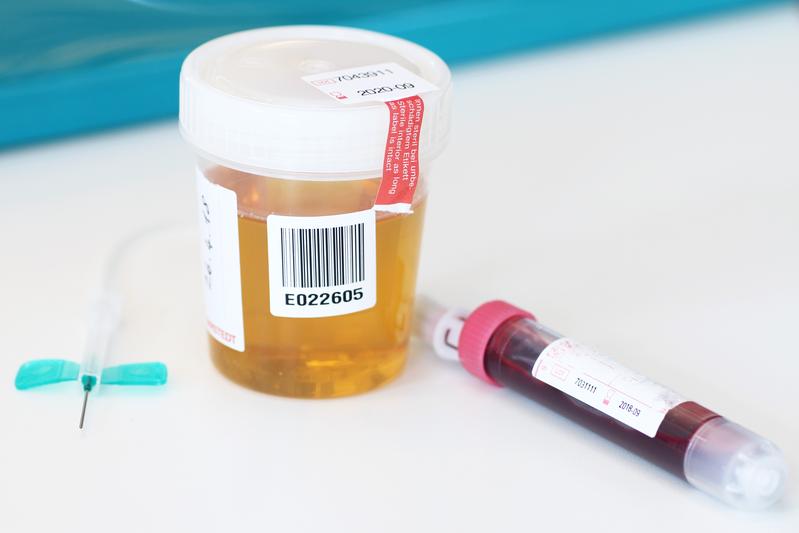

The Kiel University research team would like to use urine instead of blood in future for cancer diagnosis.
Photo: Christian Urban, Kiel University
Urine is an everyday liquid which most people pay little attention to and regard as rather unpleasant. It’s quite the opposite for a group of clinical researchers from Kiel University, the University Medical Center Schleswig-Holstein (UKSH) and the Lithuanian University of Health Sciences in Kaunas, who are convinced of the diagnostic potential of this yellowish liquid.
The reason for this is the genetic material that urine contains – especially the so-called cell-free DNA – which offers new opportunities for cancer diagnostics. The researchers in the lab were able to extract just as much as cell-free DNA from 60 ml of urine (about half a urine beaker) as from a 10 ml blood sample.
The research team is working on developing new procedures to extract cell-free DNA from urine for this purpose. Together with their international colleagues, the researchers from the Institute of Clinical Molecular Biology (IKMB) at Kiel University have now published their findings today in the current issue of the journal BioTechniques.
The term cell-free DNA refers to fragments of genetic information that are found outside of cells in various bodily fluids. These DNA components originate when body cells die – but also when tumour cells die. They are initially released into the bloodstream, and from there also make their way into the urine.
The research team initially encountered a series of problems: the amount of DNA in urine differs greatly from person to person, and even varies significantly in the same person from day to day. This meant that the DNA concentrations in the samples were initially sometimes too low, so that the researchers had to increase the respective quantities of urine collected.
They also regularly observed that the urine of healthy women contains more than twice as much cell-free DNA than the identical amount of urine in healthy men. This factor must be taken into account in future cancer diagnostics, so that these gender-specific differences do not distort the results.
To date, tests for diagnosing cancer are mostly based on blood samples. Some of these blood tests use cell-free DNA, which may originate from a possible tumour, to identify certain types of lung and colon cancer. In the next twelve months, the scientists plan to carry out further research in the IKMB laboratory at Kiel University, to determine whether genetic material from urine is as suitable for clinical research and diagnostics as blood.
“To do so, we will examine available samples from study participants at the University Medical Centre, and compare the genetic traces of a tumour in the blood plasma and urine to determine whether both methods can reliably detect the disease,” said Michael Forster, a scientist at the Institute of Clinical Molecular Biology at Kiel University.
In future, the researchers in Kiel hope to develop a urine-based test which is as reliable as traditional blood tests. This would primarily benefit patients, who would be spared the unpleasant blood withdrawal. In addition, such a test procedure would be faster and less expensive than the previous methods – for example, unlike with blood tests, no medical personnel are required when taking urine samples.
“In the United States, a similar test procedure is already commercially available for cancer research. Recently, an international research team also presented a new urine test, which has not yet been clinically approved, for certain tumours in the urinary tract,” said Forster regarding the current state of progress. “The introduction of new urine-based clinical tests in Germany still requires several years of clinical research, as well as further cost/benefit analysis,” continued the molecular geneticist.
The follow-up research will be carried out in cooperation with external clinical research groups, within the framework of the new Competence Centre for Genome Analysis Kiel (CCGA Kiel). The CCGA Kiel is Germany's largest academic high-throughput sequencing centre.
It has received funding from the German Research Foundation (DFG) and the Federal Ministry of Education and Research (BMBF). Operating one of the four newly-created sequencing super-centres in Germany, Kiel University is servicing the exploding demand for complex genome analysis in the life sciences,.
Original publication:
Greta Streleckiene, Hayley M Reid, Norbert Arnold, Dirk Bauerschlag, Michael Forster (2018): Quantifying cell free DNA in urine: comparison between commercial kits, impact of gender and inter-individual variation BioTechniques
https://dx.doi.org/10.2144/btn-2018-0003
Photos are available to download:
http://www.uni-kiel.de/download/pm/2018/2018-165-1.jpg
Caption: The Kiel University research team would like to use urine instead of blood in future for cancer diagnosis.
Photo: Christian Urban, Kiel University
http://www.uni-kiel.de/download/pm/2018/2018-165-2.jpg
Caption: The leader of the study, Michael Forster, together with his colleagues Regina Fredrik (left) and Nicole Braun from the Institute of Clinical Molecular Biology at Kiel University.
Photo: Christian Urban, Kiel University
Contact:
Michael Forster
Institute of Clinical Molecular Biology, Kiel University
Tel.: +49 (0)431-500-15136
E-mail: m.forster@ikmb.uni-kiel.de
More information:
Institute of Clinical Molecular Biology, Kiel University
http://www.ikmb.uni-kiel.de
Christian-Albrechts-Universität zu Kiel
Press, Communication and Marketing, Dr Boris Pawlowski, Text/editing: Christian Urban
Postal address: D-24098 Kiel, Germany,
Telephone: +49 (0)431 880-2104, Fax: +49 (0)431 880-1355
E-mail: presse@uv.uni-kiel.de, Internet: www.uni-kiel.de , Jubilee: www.uni-kiel.de/cau350
Twitter: www.twitter.com/kieluni, Facebook: www.facebook.com/kieluni












